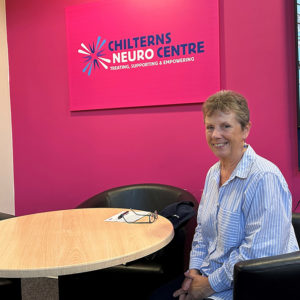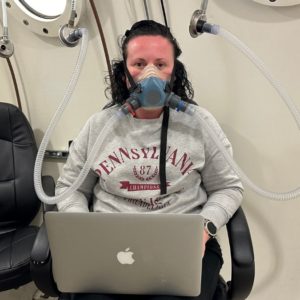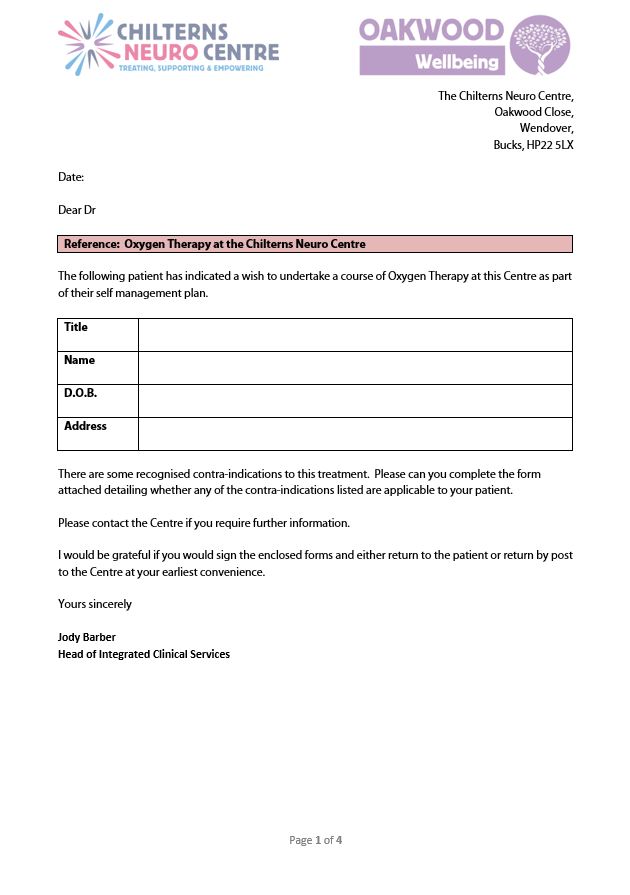Oakwood Wellbeing Hyperbaric Oxygen Therapy
Hyperbaric oxygen therapy
Oakwood Wellbeing is now offering hyperbaric oxygen therapy to those who require it and meet the eligibility criteria set out below. The service will use the facilities of the Chilterns Neuro Centre as well as staff and volunteers.
What are the benefits of hyperbaric oxygen therapy?
The air we normally breathe contains 21% oxygen. Hyperbaric oxygen therapy delivers 100% oxygen at a pressure greater than normal so that a higher level of oxygen can be dissolved in the blood. This higher concentration of oxygen is thought to promote healing within the body tissues.

Oakwood Wellbeing is a company wholly owned by the Chilterns Neuro Centre and all money raised through the company is put back into the charity to help us achieve our vision that all people affected by MS, Parkinson’s and strokes can live life to the full.
Overcoming Long-Covid through hyperbaric oxygen therapy
“I feel like I have my old life back! I can walk over three miles with my Nordic walking friends at a brisk pace. As well as enjoying several walks every week, I can do several hours gardening in my own garden!”
Oxygen therapy gives me the energy to work
“Receiving Oxygen at the Centre enables me to live a pretty normal life and is the main reason I have been able to continue working. Without it, there is no way that I would have the energy to work as much as I do.”
Conditions treated
Oakwood Wellbeing is able to offer hyperbaric oxygen therapy to those with the following conditions, and this is in accordance with the medical advice we sought:
- Sports injuries and musculoskeletal injuries
- Fibromyalgia
- Interstitial Cystitis
- Long Covid-19 (providing the user remains under the continued care of the Consultant/GP managing their Long Covid condition and written confirmation given that no known lung scarring has occurred)
Before oxygen therapy commences, the Oxygen Therapy at the Chilterns Neuro Centre Form needs to be completed by your GP and returned to the Centre.
Exclusions at the current time, due to lack of supporting clinical evidence:
- Wound healing
- Minor burns and trauma
- Diabetic leg ulcers
This list aims to exclude any users deemed to be at a higher risk of complications caused by using hyperbaric oxygen therapy for the self-management of symptoms.
- Cancer patients (currently undergoing treatment or history of previous Stage 3 or 4 cancer)
- Previous history of pneumothorax or mechanical ventilation
- Known symptomatic or asymptomatic pulmonary lesions, lung cysts or bullae
- Previous history of lung trauma or thoracic surgery
- Chronic Obstructive Pulmonary Disease
- History of asthma
- Implanted devices – unless safety is confirmed by manufacturer that pressure testing has been undertaken.
- Epidural pain pumps
- Poorly controlled epilepsy
- Past medical history of seizures / fits
- Insulin dependent diabetes
- Poorly controlled Type 2 diabetes
- Inability to equalise ears / sinuses
- Eustachian tube dysfunction
- Osteosclerosis (abnormal bone growth within the ear)
- Perilymph fistulas (tear or opening within the inner ear)
- Claustrophobia
- Congenital spherocytosis (red blood cell disorder)
- Are pregnant or trying to become pregnant
- Have had recent eye surgery – Ophthalmology Consultant to advise before oxygen therapy started or resumed.
Temporary conditions when Oxygen Therapy is contraindicated for their duration
- Upper respiratory tract infection (cold, chest infection)
- Fever/high temperature
- Ear infection
- Any infectious illness (You will be sharing the chamber with other users)
- Current episode of optic neuritis or sudden sight loss
- Pregnancy
- Recent eye surgery
Use of the following medications is also contraindicated
- Bleomycin
- Disulfiram
- Cisplatin
- Mafenide (Sulfamylon)
- Doxorubicin
- Participation in a drug trial until safety is confirmed by the clinical trial team.
Please note that the following compounds cause vasoconstriction and reduce the effectiveness of Hyperbaric Oxygen Therapy. They should be avoided prior to oxygen sessions.
- Nicotine
- Caffeine
- Cocaine
- Amphetamines
How it works
During the session, you will be sitting down and can read or use an electronic device. Wifi is available within the chamber so you can work while you’re in there.
In the chamber you will wear a mask with two tubes attached one supplying oxygen to the mask and the other releasing exhaled air. The chamber will be taken to the required pressure over a 15 minute period. During this time you may feel that your ears need to pop but this is normal. You will be breathing 100% oxygen for about one hour. After the treatment has finished, the chamber will slowly be brought back to normal pressure.
To be effective, there should be 15 sessions (five sessions per week for three weeks). It is important that users attend the initial three weeks as it gradually builds the pressure to 2 ATA (atmospheric pressure). In the first week, you will receive oxygen at 1.5 ATA and the following week at 1.75 ATA. You must attend at least three sessions per week during this initial period.
The service is offered as self-management so after the initial 15 sessions, you can decide how many sessions you would like to attend, subject to availability.
Charges
The initial 15 sessions are charged at £300 it total. Following sessions will be charged at £30 per session or £200 for a booking of 8 sessions.
In addition to this, there is also an initial cost of £100 to cover your oxygen mask.
All payments to be made in advance.
Bookings
If you would like to book onto our hyperbaric oxygen therapy service then please complete the form below or email JoKendall@chilternsneurocentre.org
|
